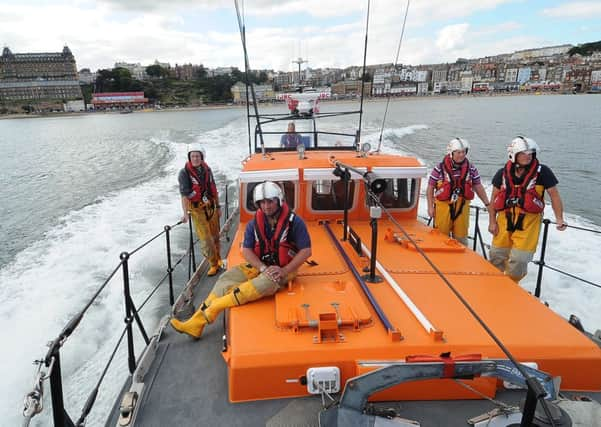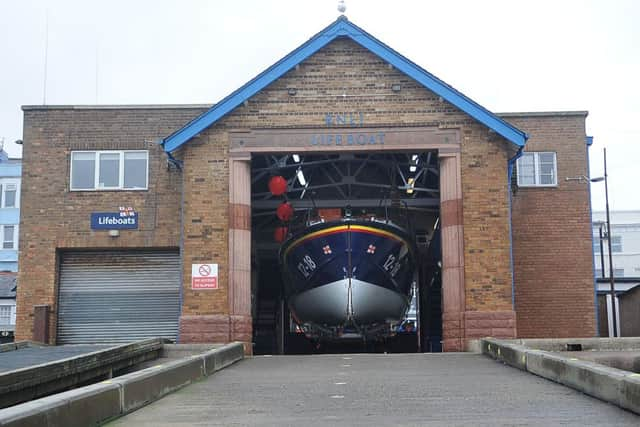The real life Action Men


SUMMER and winter alike, it’s the sight that draws visitors to the foreshore like a magnet.
The lifeboat ploughing back home through heavy seas, maybe with a stricken vessel in tow, perhaps with soaked and shaken survivors aboard, the volunteer crew exhausted after hour upon hazardous hour.
Advertisement
Hide AdAdvertisement
Hide AdAnd sometimes, there’s nobody there to watch at all, apart from the rest of the volunteers at the station waiting for their colleagues to come home safely, when the call happens on Christmas Day, or in the small hours of a bitter February morning, when the town is tucked up in bed.


It’s been this way for more than 200 years at Scarborough, the country’s third oldest lifeboat station, ever since the town launched an appeal to buy its first boat in 1800, raising £212 1s 6d, and cheered it into service the following year,
Now the echoes of that far-off fund-raising drive are to be heard at the lifeboat station once more, as another appeal gets under way to ensure that the lifesaving tradition continues.
The RNLI is, of course, a charity that receives no Government funding and raises the money needed to operate the lifeboats, which are overwhelmingly crewed by unpaid volunteers, from the public.
Advertisement
Hide AdAdvertisement
Hide AdIn 2015, Scarborough’s all-weather lifeboat, Fanny Victoria Wilkinson and Frank Stubbs, will be replaced by a state-of-the-art Shannon-class vessel, powered by water jets, and capable of 25 knots, which is 50 per cent faster. The station will be one of the first in the country to receive the new breed of lifeboat.
The £2m cost has been funded by donations from the F W Plaxton Charitable Trust, set up by the late businessman Frederic ‘Eric’ Plaxton in memory of his father, Frederick William Plaxton, founder of the coach building firm Plaxton Ltd. The new lifeboat will be named after him.
But in order to launch and recover the new lifeboat, a specialist vehicle called a Supacat is needed. Legacies have covered most of its £1.5m cost, but the RNLI still needs to raise £200,000.
So once again, the town – and its visitors – are being asked to help. The station’s treasurer, Val Johnson, knows all about how potent the sight is of the lifeboat returning home, because that is what led her into fund-raising.
Advertisement
Hide AdAdvertisement
Hide AdShe and her then four-year-old son, Bevan, were in their car coming along Marine Drive when they caught sight of it. “The lifeboat was coming back, and we pulled up and watched it being hauled out of the water onto its tractor, and an hour later I was freezing cold and he wanted to see it again and again and again.
“So coming down to see his lifeboat became an interest, and at four years old, he thinks it’s like Action Man.”
Val, a civil servant, has been treasurer since 2000. She’s aware the new appeal stands in a long tradition of fund-raising in Scarborough.
“It’s an evolution of the same thing. At one time they had an appeal to buy a wooden boat, and then an appeal to buy a motor boat, and so it evolves. We are a lucky station to have our new boat funded, but there are costs around that.”
Advertisement
Hide AdAdvertisement
Hide AdShe’s aware, too, that the lifeboat holds a special place in the hearts of Scarborough’s visitors as well as its residents. Those with longer memories still recall the disaster of December 8 1954, in which three crewmen died when the lifeboat capsized near the harbour mouth after escorting fishing vessels back in foul weather.
“I often get donations from people who have died,” said Val. “I get letters from people who say, ‘My husband was born and raised in Scarborough and he’d like the money to go to the Scarborough station’, so Scarborough people move but they still remember their lifeboat.
“And a lot of people in the West Riding want to become involved, we’ve already received a lot of donations from the West Yorkshire area, because a lot of our audience come here on holidays and for day trips.
“It’s very community-based, the lifeboat generally is its own separate community. The 1954 disaster is still very much alive in people’s memory.”
Advertisement
Hide AdAdvertisement
Hide AdThe crew share the awareness of how much the lifeboat means to the town. “The lifeboat is close to the hearts of a lot of people,” said the second coxswain and deputy mechanic, Dave Jackson, 56. “If you’re part of a fishing, a seaside town, most people have a lot of fondness for the local lifeboat.”
He’s been involved for the past 12 years, after being invited out on the boat by its coxswain, Tom Clark, whom he knew from the local sub-aqua club. Once upon a time, most of the crew were drawn from the fishing fleet, but as that has declined, they now come from a spread of occupations. Dave is an electrician. Fond as he is of Fanny Victoria Wilkinson and Frank Stubbs, the prospect of the new Shannon class boat fills him with excitement.
“It will be a big learning curve, a totally different boat and getting used to new equipment. They will possibly bring a boat to train on. Our boat is great, but just as this was a massive step up from the old boat, I’m sure it will be the same when the new boat arrives.”
Somebody else who is looking forward to it is one of the youngest crew members, Matt Marks, 24, who has been a volunteer for the past year.
Advertisement
Hide AdAdvertisement
Hide AdHe’s an intensive care nurse. “I don’t come from a fishing or sailing background, but I’ve always liked the water. I came down for the first night and seemed to get on with everybody. All the crew have got a wealth of knowledge and they are all up for showing you the best way of doing something.
“There is so much stuff to get your head round. We were out doing training, and a yacht got stuck in the mouth of the harbour, and it was interesting to think, ‘This is going to be real, then’.”
It’s real, all right, every time the crew’s pagers go off whatever the hour of day or night. Dave recalls spending a Christmas Day 50 miles out at sea with a stricken vessel. The new boat will get the crew there faster than ever, and the launch vehicle that is the subject of the appeal will ensure that it is away and recovered within minutes. The determination to help is as powerful now as it was when the first fund-raising appeal was launched in Scarborough more than two centuries ago.
Val said: “I look at those lads and I see the job they do, and we want them to have the best kit, the best equipment and we want them to go out and come back safely, because it can be horrendous out there.
Advertisement
Hide AdAdvertisement
Hide Ad“You sit and think sometimes, ‘It’s four o’clock on a February morning, the pagers go off, I’m going to get under my duvet, these lads will be put to sea within 10 minutes irrespective of what the weather’s doing or how the sea’s running, and it’s that commitment that I feel I can support if I raise the money.”
Donations can be made by contacting Scarborough Lifeboat Station on 01723 360520, or sent to Scarborough Appeal, RNLI, Scarborough Lifeboat Station, West Pier, Foreshore Road, Scarborough, YO11 1PB.
Next week Whitby prepares to commemorate one of the bravest episodes in its proud and sometimes dangerous history.